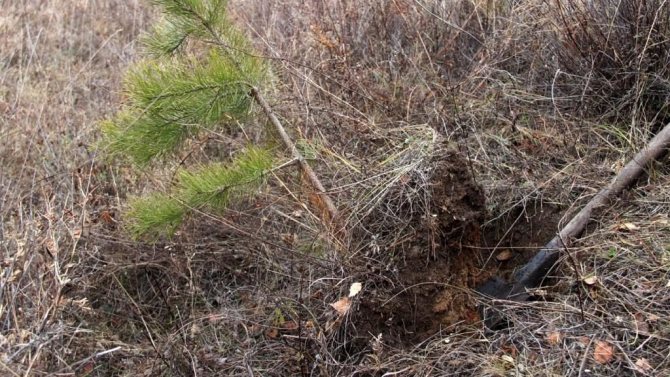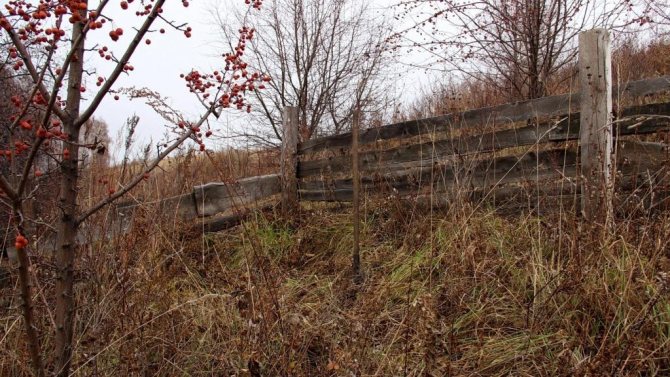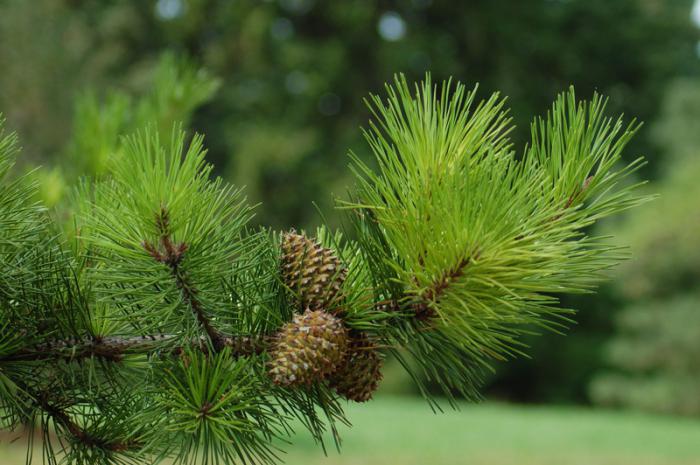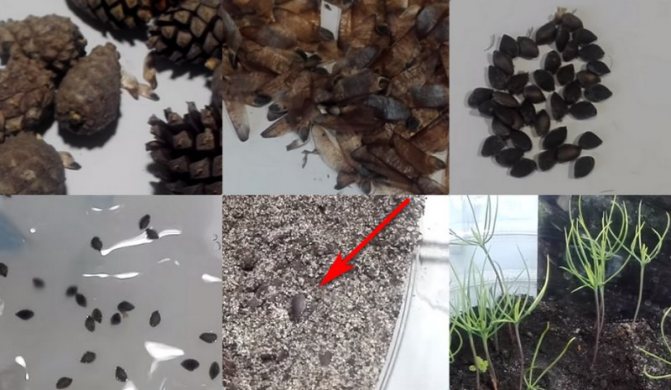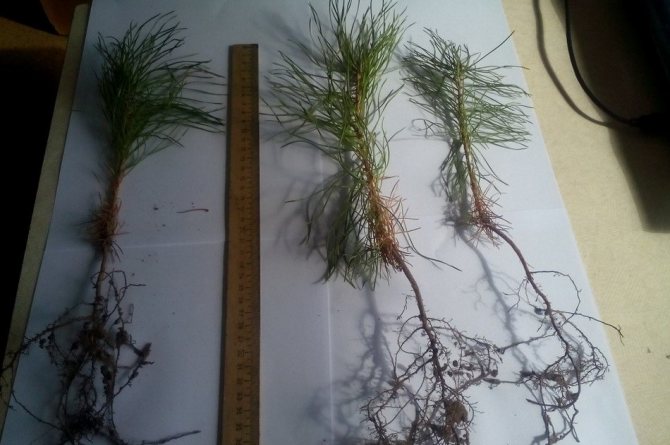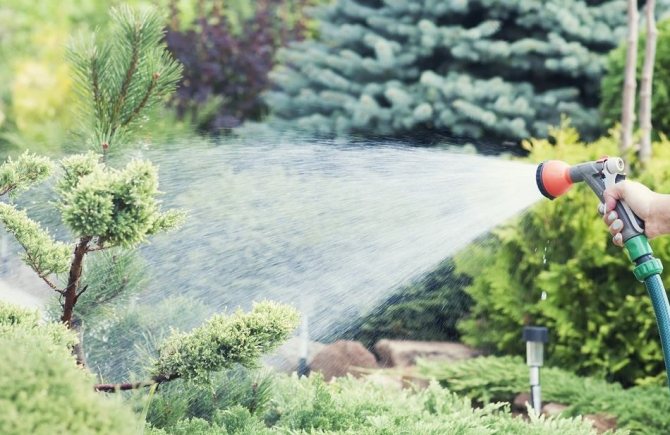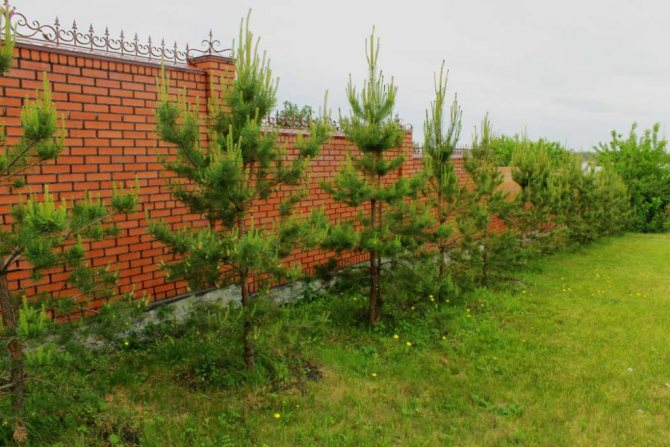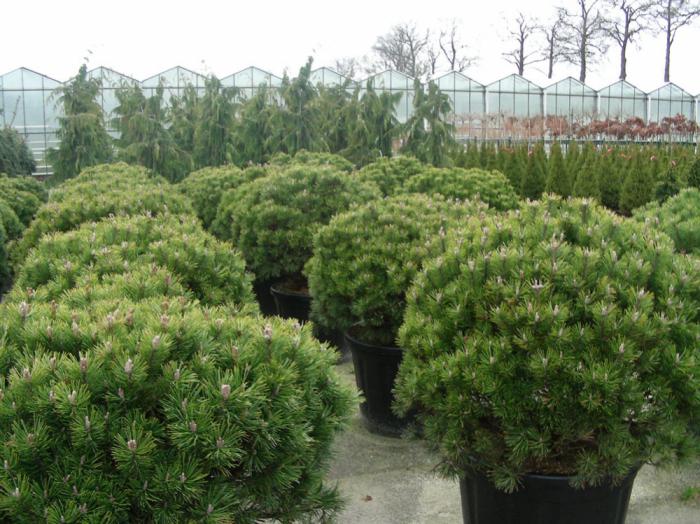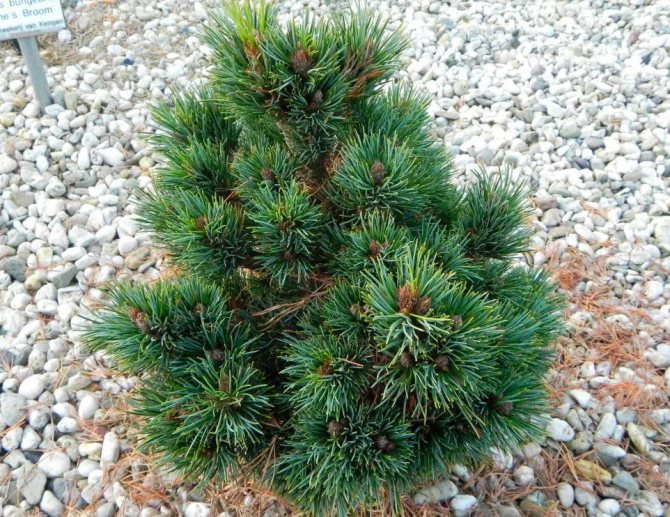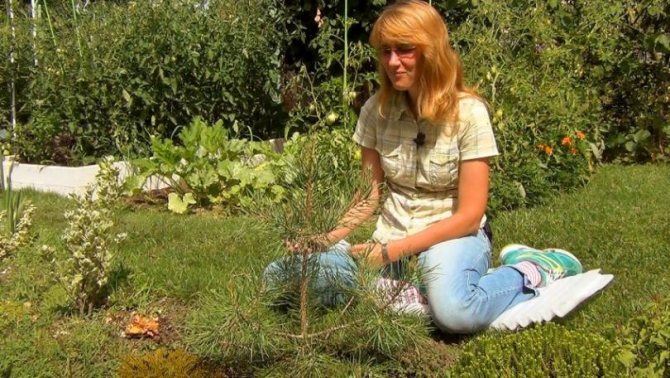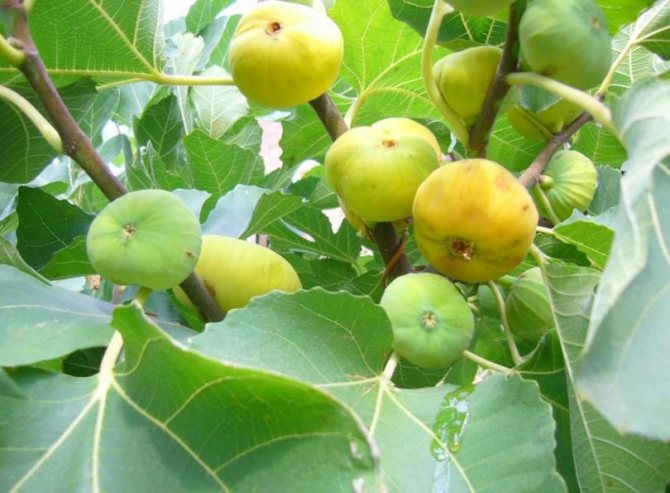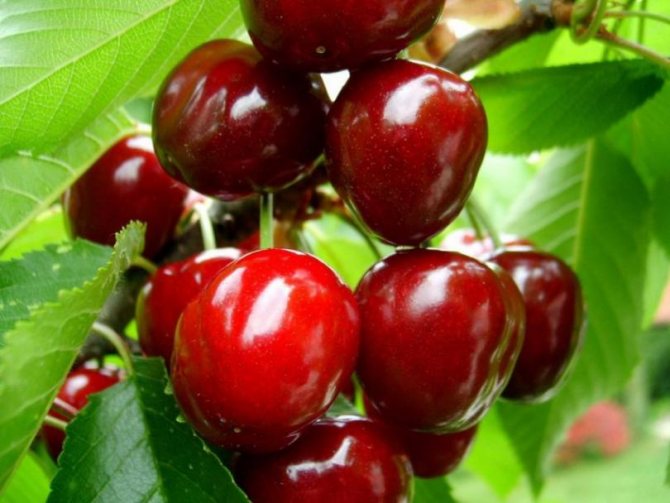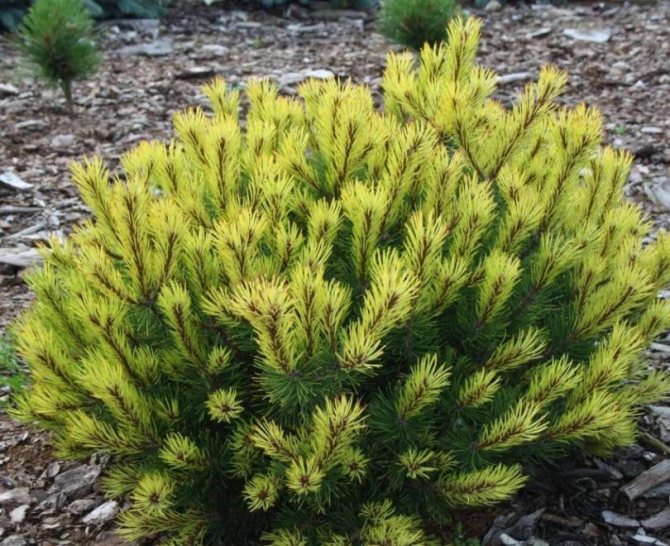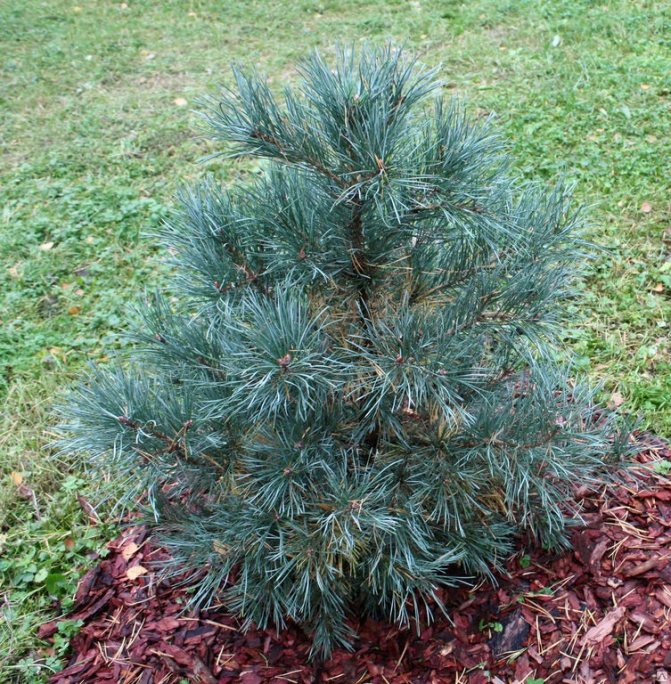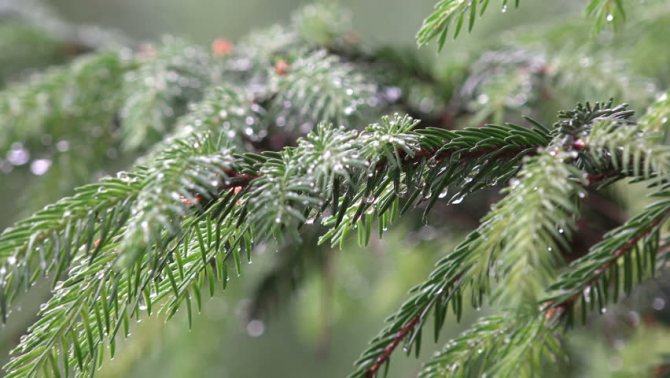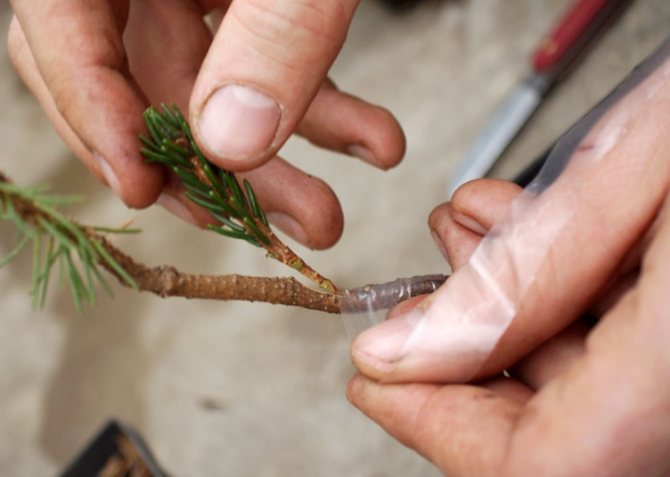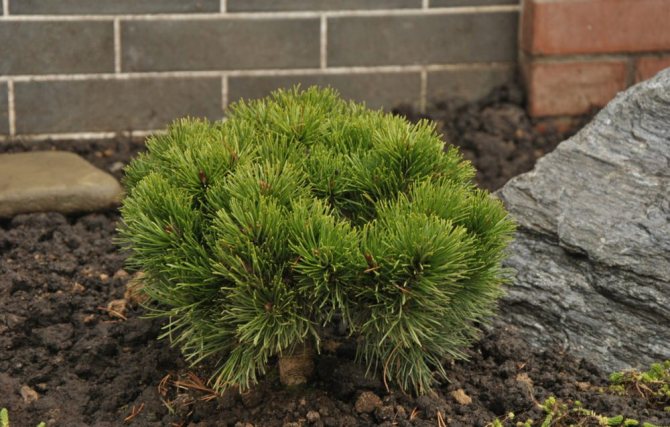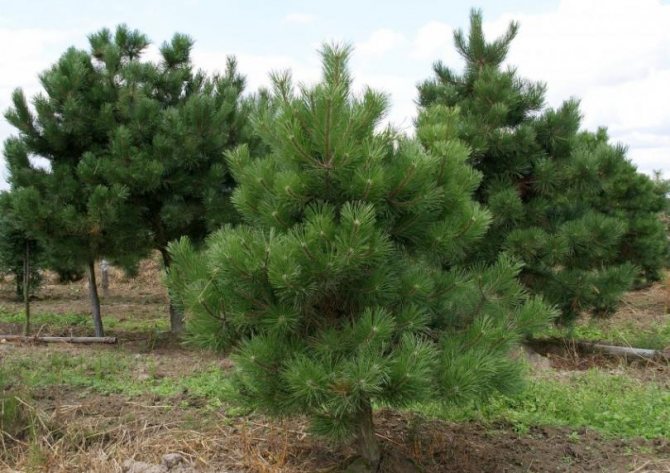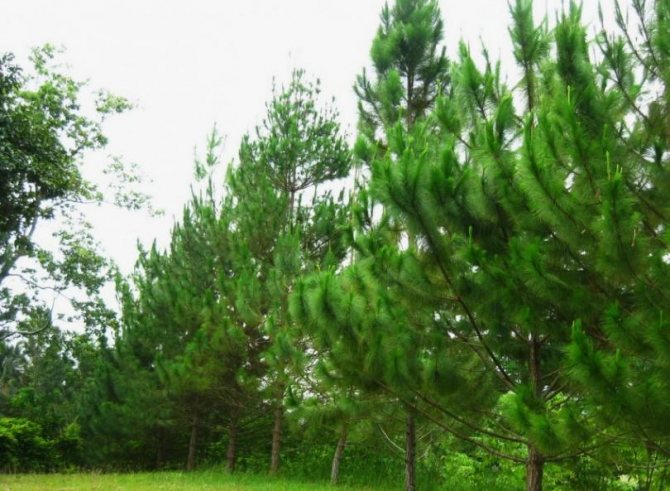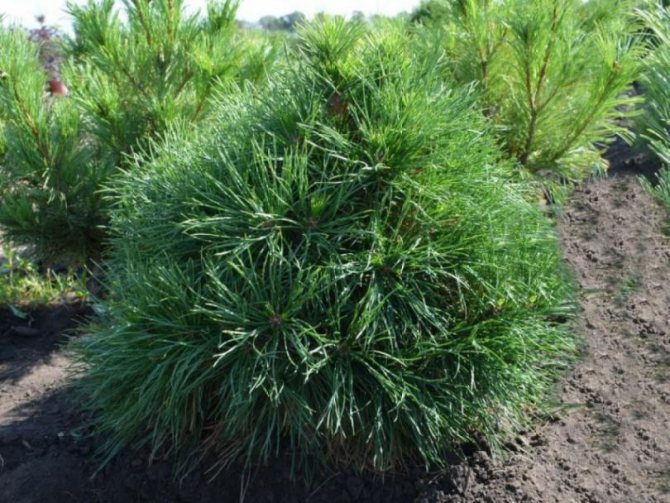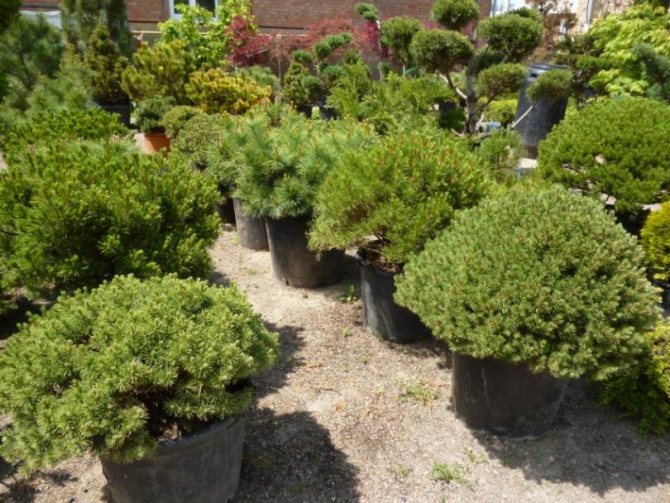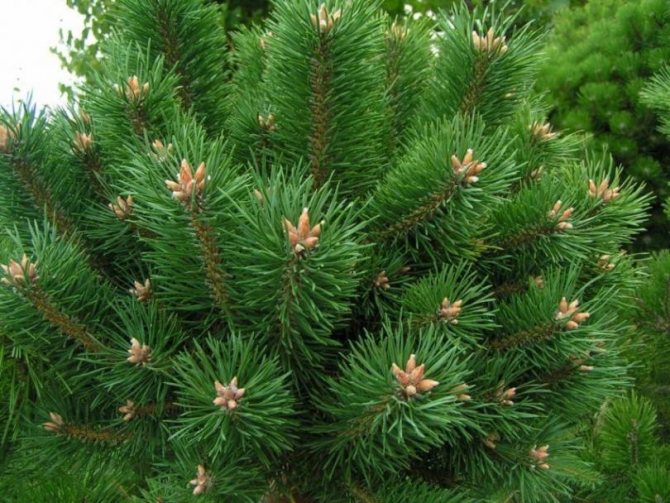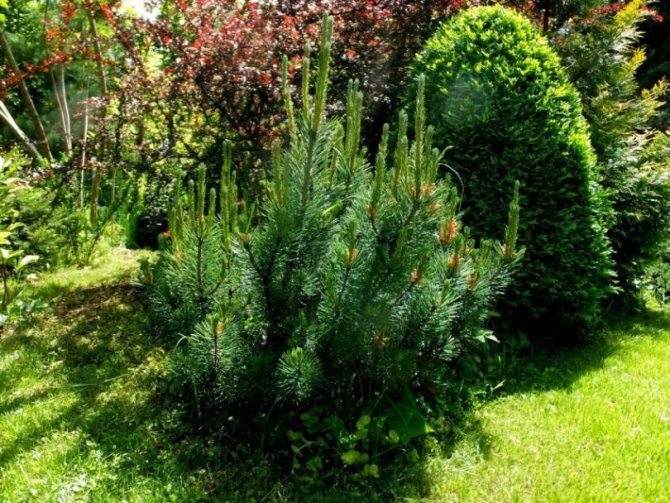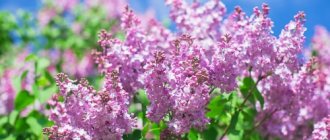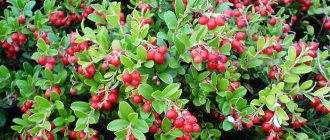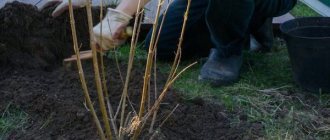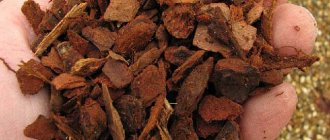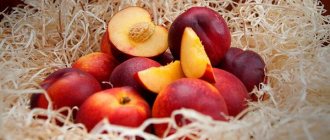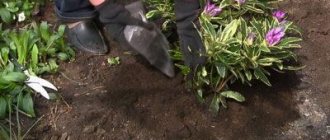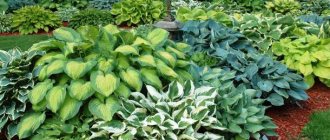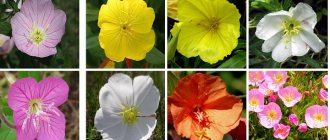Many summer residents want to grow not only vegetables and flowers on their site, but also coniferous crops that retain their decorative effect all year round. There is nothing more beautiful than a forest, and a part of it can be created in the country, if you choose the right place and type of plants. Among the large number of conifers, pine occupies a special place.
The tree has been growing for many decades, looks beautiful against the background of the country landscape, perfectly cleans the air from city smog and other chemical emissions. It saturates it with phytoncides - medicinal substances useful for the respiratory system. Natural forest aroma, reliable shelter from wind, sun and rain, indescribable beauty - all this can be created by just a few pine trees at their summer cottage.
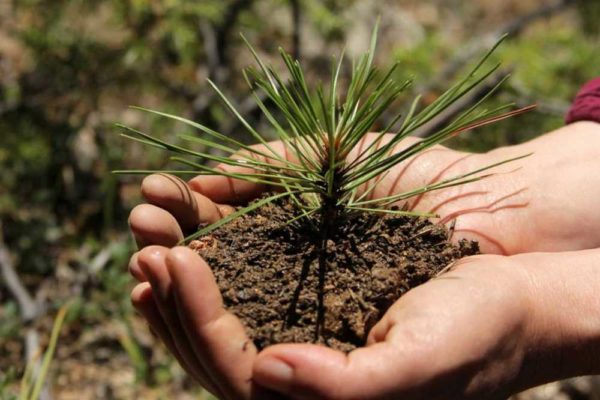
When to plant a pine
How to choose the right tree
For transplanting to a personal plot, you should choose low pines. The optimal height of the tree is 60-100 cm. It is important to take into account that a small seedling is much easier to deliver to your home. The desired age of the transplanted tree is 3-5 years.
Older trees may not adapt to new conditions, and young pines do not have enough vitality to easily transfer a transplant.
Dig a pine tree with a bayonet shovel, immersing it in the ground at a distance of 50-60 cm from the trunk. Dig deep enough so as not to damage the root system. The length of the root is most often identical to the height of the seedling.
A properly dug seedling on the roots should have a clod of earth weighing about 20 kg.
In addition to a shovel, you need to take with you a large piece of cloth and water. Immediately after digging out the seedling, a clod of earth enveloping its root system is wrapped in a wet cloth. Otherwise, bare roots may die within 10-15 minutes.
Let's watch a video about transplanting a pine tree:
Answers on questions
Let's discuss the causes of several problems that most often arise when planting a pine tree.
Why doesn't the tree take root?
The most difficult question has no definite answer. The tree is quite capricious, any deviation from the recommended agricultural technology can cause a negative result.


It often happens that the seedlings do not take root and dry out, despite all the efforts of the gardener
But more often than not, several common mistakes lead to sad consequences.
- Critical root damage. Moreover, they are damaged not only during digging, but also when landing in a very small hole. Every effort must be made to keep the roots in the same position as before transplanting. One more nuance. The roots also receive mechanical damage during backfilling with earth, it should be tamped with not very great effort, but also do not leave the roots in the air completely not covered with earth.
- Poor quality planting material. Not every tree is suitable for transplantation; it is strongly recommended to reject patients with obvious signs of developmental abnormalities.
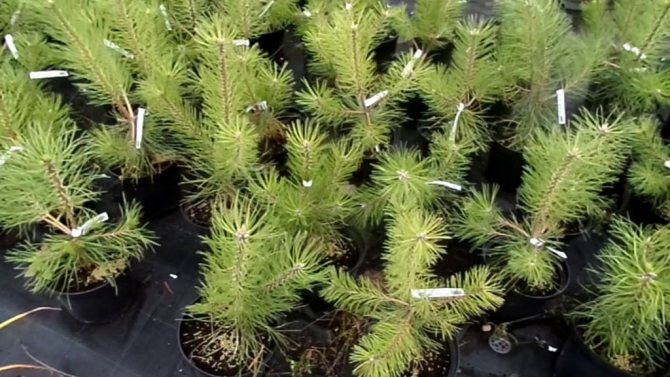

The highest quality seedlings can be purchased only in the nursery. - Groundwater is located very close. Pine grows poorly on the banks of rivers and lakes, if you have such a site, then it is recommended to plant trees on bulk hills.
- Planting capricious pine varieties.The trees must be acclimatized to the region, and if you are trying to plant a southern tree in the north in pursuit of its beauty, you must be prepared for failure.


The best varieties of pine trees for summer cottages
How to properly examine the roots of a tree?
The survival rate depends on the state of the root system of seedlings. Never buy seedlings with bare roots, the suction roots of a pine die in 20-25 minutes. after removing the land. For their recovery after planting, the tree has no time, evergreen needles constantly need moisture, the pine pulls it out of the large roots of the skeleton. As a result - the death of the entire root system. Deciduous trees in such a situation shed their crown and give time for the roots to regrow, evergreen needles do not shed.


The seedlings should not have bare roots.
Do forest pines take root or do you need to buy special seedlings?
With the proper skill, replanting a forest tree is possible, but several conditions must be met.
- Have permission from the forester, otherwise you have to be ready to pay a huge fine. This rule applies not only to townspeople, residents of remote Siberian villages also do not have the right to dig up pine trees for planting at home.
- The height of the tree is no more than 1.5 m. This limitation is not directive, but practical. If there is no special equipment and a team of workers, then you are unlikely to be able to dig up a large tree. It will always have critical root damage. Such a seedling dies the next year, at best, fresh growths and the crown of the head will remain, and the needles will crumble from the lower needles and they will dry out.


In the forest, you need to choose small trees - this way the chances of a successful planting increase significantly
Remember that in the forest, the pine stretches up in search of the sun, bends and stretches, the appearance is not very beautiful. Choose trees that grow separately.
What varieties are suitable for planting in the Moscow region?
Cedar pine feels great in this region (not to be confused with Siberian cedar). You can buy seedlings up to 2.5 m in height, after 10-15 years the tree gives a harvest. In nature, cedar pine gives cones only from the age of 60.
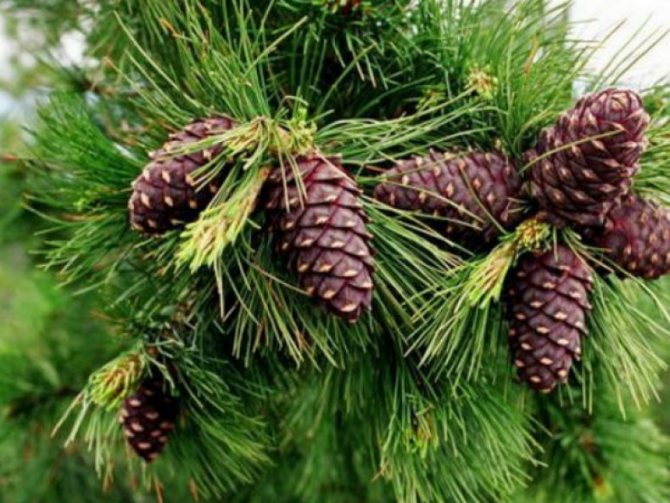

Cedar pine
For decorative purposes only, it is recommended to plant a simple cedar pine, it grows quickly, has a regular and very beautiful shape. But you need to know that young plants are often damaged by the pine beetle, you must constantly fight with it, otherwise the tree will die. Recently, many summer residents have been buying Norwegian pines, they are distinguished by their unpretentiousness and almost one hundred percent survival rate. The disadvantage is the rather high cost. The mountain species Pug and Gnome feel great, they have a dense crown and are almost not damaged by pests. The disadvantage is that the seedlings are very small and expensive.
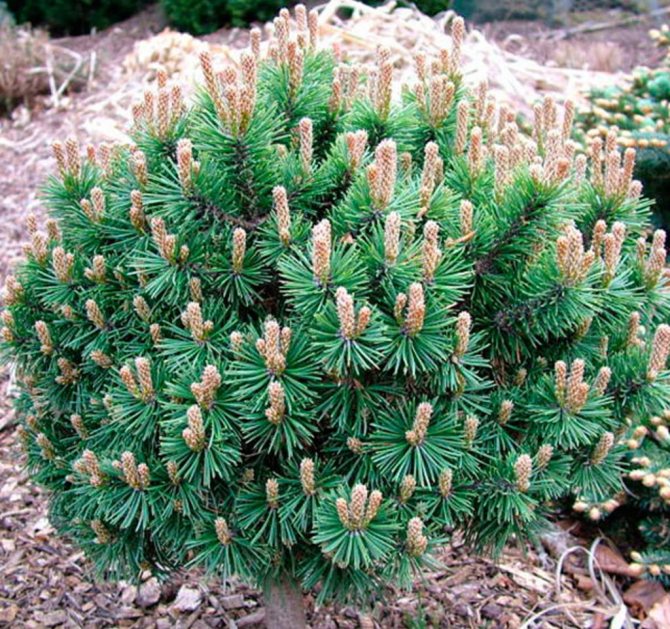

Low-growing pine Pug Midget
Do I need to thin out the branches of the pine?
If there is a desire to form the crown on its own, then it is recommended to break off only young shoots. The branch stops growing in length and fluffs up due to lateral ramifications. Such breaking off the tree is much easier than pruning.
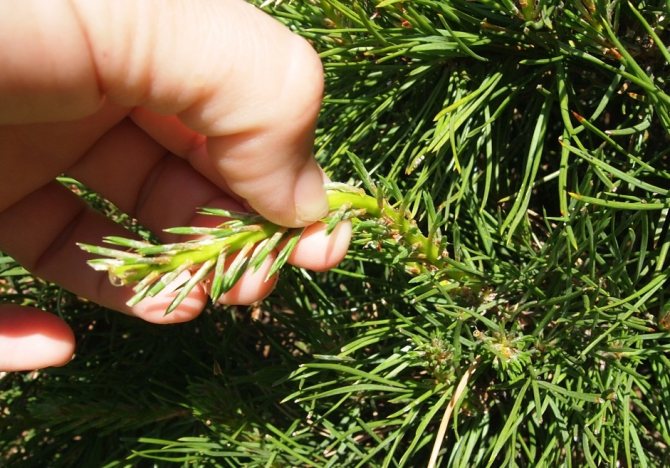

To form the crown, it is recommended to break off only young shoots.
Is it possible to make a lawn under a pine tree?
No you can not. The tree inhibits the growth of all other plants, only some of the most viable forest grasses can survive in such conditions. And then their appearance is unhealthy and does not cause pleasant associations.
Video - When to plant a pine
Pine - a typical forest tree, creates a special atmosphere around itself, promotes relaxation after a busy work week. But the forest is not only trees and shrubs, it is also the singing of birds. On the personal plot, only sparrows are most often found, forest birds do not want to fly into such places. You can attract them with food, you need to hang a feeder on a pine tree. And how to make a bird feeder yourself can be found in the article on our website.
Where is it better to plant pine
To plant a pine tree from the forest on your personal plot, you should carefully choose a suitable place. It is not necessary to dig a hole for a young tree in a place open to the wind. Pine is a forest tree, and drafts are not a habit for it.
Young seedlings transferred to unfamiliar conditions are especially sensitive to gusts of cold wind. A place for a pine tree should be selected quite quiet, but bright. The needles can be planted in the garden next to the fruit trees or near the house, the walls of which will protect it from drafts.
However, the pine should not be planted closer than 5 meters from the wall. While developing, the root system of a tree can destroy the foundation.
It is advisable to choose a place with a slight incline. It's also important to keep distance in mind. There must be a distance of at least 2.5 meters between trees. If you plan to grow a tall pine tree, you should step back from other trees at least 4.5 meters.
Pines and spruces actively take all the moisture from the soil. Other plants do not take root under such trees. It is advisable to take this fact into account before choosing a future site for planting.
Chernozem, ideal for fruit trees, is completely unsuitable for needles. The pine needs a sandy soil to provide drainage for its root system. It is important to take into account the groundwater level at the site.
If underground rivers are close enough to the surface, the tree may die several years after replanting. This is due to the fact that its deeper root system will begin to rot.
How to care for an immature plant?
A properly transplanted coniferous seedling is half the battle. Providing quality care is essential for good growth. Favorable growing conditions are provided as follows:
- When planting in the spring after rooting, the plants are not watered. There is enough natural precipitation. If the coniferous culture was transplanted in the fall, it should be watered abundantly. Watering is stopped 10-15 days before the onset of the first frost.
- You can form a beautiful crown with balanced feeding of pine, minerals. Up to 40 g of nitrogen-based fertilizers and about 5 kg of manure are applied under the root.
- The first 2 years after transplantation, the young tree is covered before the onset of winter. It is especially important to cover seedlings that were planted in the fall and did not have time to fully take root. An adult culture can easily withstand frosts below -40 ° C.
- Often, a young pine tree actively develops for the first 2 years, and then dies. This happens when groundwater is close to the surface. The overgrown root system reaches the groundwater, which causes it to rot.
Important: abundant watering is allowed only if quality drainage is provided.
Otherwise, the root system will suffocate in the water, and the pine tree will die.
Gardeners recommend watering often, but in small doses. Leave a distance of at least 200 cm between adjacent trees so that the roots do not intertwine.
You clearly lack the resinous smell, evergreen needles and, in general, a beautiful fluffy tree in your summer cottage. There is a desire, but there is no way to buy yet. In this case, you can transplant a viable and unpretentious pine tree from the forest to your dacha and thus acquire an ephedra, which will give you joy for many years. However, in order for a young seedling from the wild to fall in love with your estate, and the change of place was less painful, it is necessary to take into account a number of features inherent in this tree species. We will tell you how to make the dream of a green friend come true in our article.
What species and varieties are not represented by pines, but the most famous are:
Note!
As a rule, in the forest you will most likely find
ordinary pine.
Planting pine trees in the fall from the forest
For a young pine tree, you need to dig a large enough hole.A clod of earth brought on the root system and crushed stone should fit there. The recommended depth is at least 70 cm. A small amount of natural fertilizer - horse or cow manure - can be placed on the bottom of the pit.
Manure must be sprinkled with a layer of soil - otherwise the root system may burn. Gardeners advise using gravel for drainage. When planting, the hole is filled with 15-10 cm of crushed stone. A seedling dug out in the forest should not be kept outside the soil for a long time. It is best to plant the tree on the same day it was dug up. Moreover, a pine tree is planted along with a piece of cloth, in which its roots were wrapped with a lump of earth.
Over time, this tissue will rot and further fertilize the soil. Before placing the seedling in the pit, half a bucket of water is poured into it.
At the end of planting, the soil around is mulched. Gardeners recommend taking forest needles for this - it serves as an excellent natural antiseptic and repels parasites.
If the transplantation takes place in the spring, 20-25 g of nitrogen fertilizer is added to the hole just before planting the seedling. After 2 weeks, its active components will begin to actively promote the growth of the tree.
Transplantation in the autumn period occurs without such feeding, since there is no need to "wake up" a tree ready for hibernation.
The planted tree must be immediately poured with abundant water. For 7-10 days, the tree needs to be constantly watered. If subzero temperatures are not expected, the soil around the seedling should be constantly in a small swamp state.
Experienced gardeners advise not to neglect the orientation of the pine relative to the cardinal points. To do this, before going into the forest, you need to take a compass with you and determine the paws pointing north. In order not to be confused, a bright ribbon is tied on them.
When planting a seedling in your area, you should make sure that the same branches are directed to the north side.
Let's watch an interesting video about replanting pine trees in the fall from the forest:
Reproduction of pine by grafting
Pine propagation by grafting is preferred mainly by experienced gardeners, but beginners can also try their luck.
Important! Plants aged 4 - 5 years are suitable for the stock. The graft is taken from the growth at the age of 1 - 3 years.
Plants are grafted during the spring sap flow or in the middle of summer. Spring grafting is carried out on last year's shoots, summer - on young branches of the current year. Pine grafting is carried out in two ways: with the core and cambium on cambium.
Algorithm for the reproduction of pine by the method applied with a core to cambium:
- Cut off all the needles and lateral buds from the stock. The length of the peeled part of the pine branch should be 2 - 3 cm longer than the length of the grafted cutting.
- A stalk 8 - 10 cm long is also freed from needles, leaving only 8 - 12 bunches near the upper kidney.
- After the stock and scion are prepared, you can start grafting the pine. To do this, using a sharp blade on the handle, you need to make an incision passing through the middle of the core. It should start at the top, just below the bundle of needles, and end at the bottom of the pine branch.
- Further, using a blade, in the place of the rootstock, it is necessary to separate a strip of bark of a longitudinal shape, equal in size to the cut on the prepared cutting. It is important that the cut passes over the cambial layer.
- As a final step, the cutting is connected to the exposed cambium of the rootstock and then tied tightly.
When multiplying by the method of butt cambium on cambium, the survival rate of plants reaches almost 100%. Reproduction algorithm:
- Free the axial annual shoot of the rootstock, which has reached the age of 4 - 5 years, from the needles, on an area 5 - 10 cm long.
- Trying not to damage the cambium, cut off the bark on the rootstock and scion in strips 4 - 6 cm long. It is important that the cuts on the rootstock and the scion are of the same length and width.
- Connect the places of the cuts, then tie tightly.The fusion process usually takes 4 to 5 weeks.
- After the cuttings finally take root and begin to stretch into growth, the strapping is removed.
- With the help of a secateurs, the apex of the axial shoot on the rootstock, as well as the end of the shoots on the first whorl, are simultaneously trimmed. Thanks to this, the growth of the scion is significantly enhanced.
- Over the next 2 - 3 years, all whorls should be gradually removed on the rootstock.
Features of transplanting mountain and Crimean pines
Mountain and Crimean pines are quite popular varieties of needles. They are valued for their decorativeness, which they actively use to create various kinds of landscape designs.
Transplanting these varieties has some features:
- light-loving mountain - you can even plant in a shaded place, it will still take root, although it will not develop as quickly as we would like;
- Crimean - less frost-resistant, therefore, requires more thorough protection from frost in winter.
Application
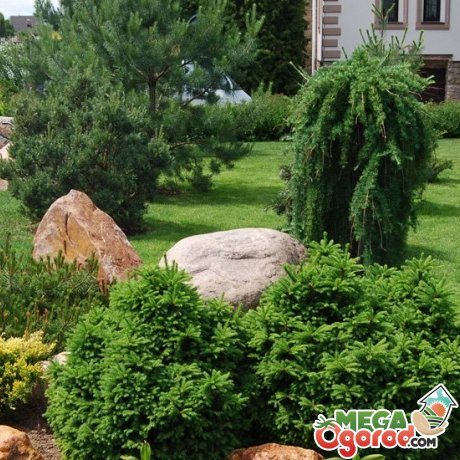

Pine is used in many industries. Its wood has a soft structure, which makes it easy to process it and prepare carved home decorations, furniture and even build houses from it. Also, this tree is often used by landscape designers to decorate an area near a house or make an alpine slide.
Many conifers have medicinal properties. Folk recipes often include young shoots or pine cones. They are used to make tinctures, medicines and lotions.
More information can be found in the video.
What kind of care does the seedling require?
In the first weeks after transplanting, the seedling requires frequent and fairly abundant watering. The tree should not be flooded "up to its ears" once a day. It is better to water it in dosage several times a day, constantly maintaining a relatively high level of soil moisture.
If the winter is dry and snowless, the tree needs to be watered even in frosts. However, it is not necessary to pour it abundantly; it is enough to provide a minimum amount of moisture. During this period, the plant is in hibernation, so there is no urgent need for a large amount of moisture.
If the owners do not plan to grow a tall tree, the pine should be pruned. All young branches are shortened by a third. This procedure is repeated every 2 years. As a result, the site will have a dense and lush, but low pine tree.
The first 2 years after transplanting, the roots of the seedling should be protected from frost.
This is especially important when it comes to trees transplanted in the fall. The lower part of the trunk and the ground around the seedling are wrapped in spandex or burlap.
Young pines need feeding. For this, seedlings are fertilized with complex mineral mixtures. 1-2 handfuls of fertilizer are thrown under a tree and poured with water for better absorption. The procedure is carried out 2 times a year - in spring and autumn.
Gradually, a litter of crumbling needles forms under the tree. It should never be removed. Such a "carpet" serves as an excellent fertilizer and reliable protection against harmful insects. In addition, the coniferous litter perfectly retains moisture.
What is the best way to prepare for landing?
These trees love sunny places, but young seedlings can die under strong bright rays. In the forest, young pines protect mature trees, they create shade. In order to solve this problem it is necessary to temporarily artificially shade the area
, for example, put plywood (which will also serve as protection from small animals).
Or temporarily plant the tree somewhere else and then transplant it back into the sun. This problem can also be solved by planting the pine near other short plants. Sooner or later, the pine tree will outgrow its neighbors and begin to receive a large amount of sunlight. Whitewashing the trunk is another way to protect the trunk of a young plant from strong sunlight.
It is worth considering that some pines reach a very large size (up to 47 m in height), these trees need a sufficient amount of space for normal life. Do not plant a pine tree near the house, as the roots of the tree can seriously damage the foundation. Also, do not grow the tree near pipes and electrical wires.
The site must be cleared of debris, stones and weeds. Other plants can interfere with the tree's normal growth, and rocks will inhibit root growth.
If the roots of the plant are tightly pressed together, then it is better to rinse them with a little water and spread them out. Thanks to this, the tree will begin to grow better with roots in width, which is why it will quickly adapt to the new site.
How to plant a pine tree in a pot
A small coniferous tree in the apartment helps to purify the air and gives it a pleasant resinous aroma. You can buy this kind of home decoration at a nursery or flower shop. If you wish, you can try replanting a small seedling from the forest.
The transplanting procedure is similar to planting a pine tree on a personal plot. The main difference is the choice of pine. For a pot, seedlings of the appropriate size are needed.
Also, the forest guest should provide favorable conditions for life:
- ensuring a low temperature during wintering. The required parameters are from -7 to 10 degrees;
- an inflow of fresh air - a pot with a pine tree should be placed on the windowsill of a window facing north;
- lighting - conifers “don't like” shaded areas;
- timely watering. Unlike mature trees growing outdoors, small pines in pots need constant moisture in the soil;
- daily spraying with warm (20-25 degrees) water.
Transplanting forest needles to a personal plot is not associated with great difficulties. Pines and spruce trees are rather unpretentious.
In the presence of suitable soil and proper care in the first days after transplanting, forest guests successfully take root in new conditions.
Care during germination
Pine is a light-loving plant, therefore, during the entire time of seed germination or rooting of cuttings, the box with young plants should be stored on the windowsill, slightly shading the sprouts from direct exposure to the sun. This is especially true of young seedlings that appear approximately on the 14th day after sowing and are particularly tender in tissues. To prevent the development of diseases, once a week, they can be sprayed with a light pink solution of potassium permanganate, simultaneously moistening the surface of the soil from the spray gun when it dries.
Soon after the next watering, it may be necessary to loosen the soil to prevent the soil from becoming crusty. This procedure must be performed as carefully as possible, using a toothpick as a tool, with which the soil is slightly fluffed in the aisles.
Find out what an almond tree looks like.
In the warm season, grown and matured seedlings should be fed 2-3 times with special mineral mixtures for conifers. It is easy to find them in ordinary gardening stores (for example, the drug "Agrecol" or "Novofert"). Dosage and application features are always indicated on the package.


How to plant a pine tree from the forest in autumn: growing and care, reproduction
Correct planting of pine on the site in the fall will strengthen the soil, saturate the air with useful substances - phytoncides and create a visual accent. Walking in a coniferous forest has a positive effect on the work of the central nervous system and cardiovascular system. People who are diagnosed with diseases of the respiratory system are recommended to plant a coniferous tree on the site. The seedlings are taken from the nursery. The choice is made in favor of planting material with closed roots. There are no restrictions on the choice of the variety. The only caveat is that fans of landscape design take the undersized Gornaya variety.
General information about pine


Pine is a perennial tree-like plant that belongs to the conifers family.It has a powerful root system, the main root looks like a rod and goes deep into the soil for several meters, long lateral growths extend from it. Some pine varieties can be up to 75 meters high. The trunk is thick, strong, covered with bark, its color can be from gray to yellow-red, sometimes peeling. The branches grow from the main trunk and grow stiff as they grow.
On young sites, needle-like needles grow in bunches from 2 to 5. Each year, the tree forms many cones, which mature in a year and throw out a large number of seeds.
Pine trees are long-lived trees and can grow for over 350 years.
Thanks to the main root, which goes deep into the ground and can get nutrients for the tree there, the green beauty grows both in fertile lands and in sandy and rocky areas. Only a few species take root in the city, since most of the pine species are highly sensitive to air pollution.
Seed selection
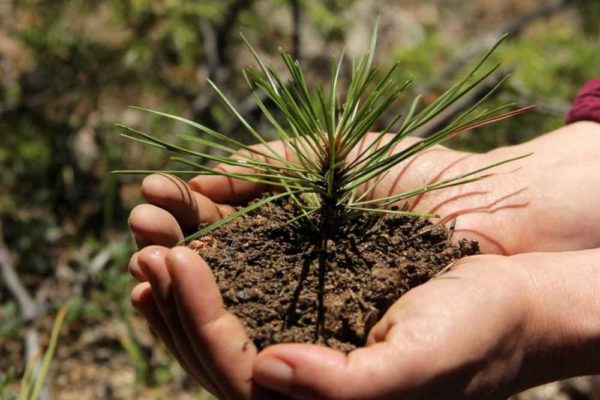

It is recommended to plant seedlings in spring or early autumn, which are more than 3 years old. Three-year-old seedlings are more likely to take root even on "poor" soil. The second option is to plant a pine tree on the site, which was dug up in the forest in the fall. Botanists do not recommend that beginners do this. It is impossible to independently determine which young tree is in good health.
Transplanting a seedling from the forest
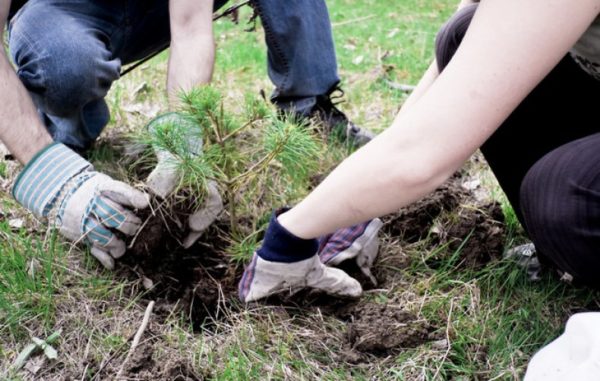

The recommended tree height is from 60 to 120 cm. You should not exceed the specified threshold, otherwise you will not be able to plant a pine tree from the forest on the site. They dig up a tree with an even trunk. Use a bayonet shovel. It does not damage the root system. The further procedure is as follows:
- a radius of 50 cm is dug around the tree - it is necessary so that the pine transplant from the forest takes place without damaging the rhizome;
- deepen as much as possible in order to extract the earth together with the root system;
- together with the roots, you need to extract up to 20 kg of earth.
Gardeners who want to take pine from the forest should not take bare roots for two reasons. The first is that the seedling will not take root. Second, you will need 4-5 times more fertilizers.
Self-propagation of needles
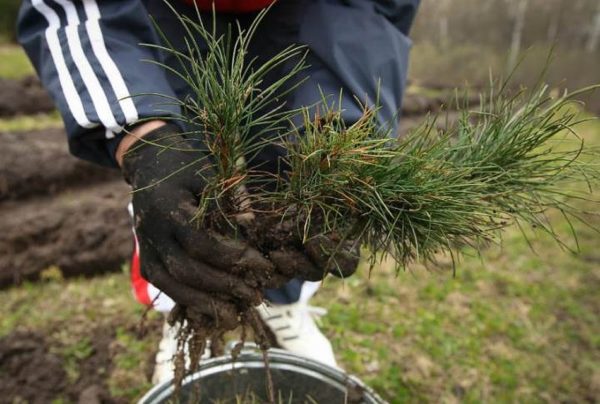

Self-planting of pine on the site in the fall is carried out using existing trees. The procedure is as follows:
- seeds are taken only from healthy trees;
- for 2 months they are placed in the refrigerator (not in the freezer);
- put them in a container with water, the temperature of which is +35 + 40 С;
- duration of water procedures - 30 minutes;
- seeds are planted in a prepared box;
- there must be constant air exchange inside the container;
- placed where they receive a sufficient amount of sunlight;
- from the moment the seeds are planted until the first shoots appear, the pots are covered with foil;
- soil is poured inside the box, which is mixed with peat and black earth in a ratio of 1k1;
- seeds go underground to a depth of 3 cm;
- the seeds are planted at a distance of up to 2 cm from each other.
As soon as the Scots pine has sprouted, it is transplanted into open ground.
Features of the reproduction of different types of pine
First of all, you need to decide on the type of pine that you plan to grow. Different species have their own characteristic breeding characteristics. So, for example, when propagating by branches, the European pine tree takes root best of all. However, in the climate of central Russia, Scots pine and Siberian cedar pine are most often found.
When propagating by seeds, it should be borne in mind that the seeds of different types of pines differ in their appearance. Scots pine seeds have small wings that allow them to move in the air. Siberian pine seeds have no wings. They consist of a core covered with a dense woody shell.
Seat selection
A gardener who wants to plant a pine tree correctly on the site pays attention to the composition of the soil. It is good if the sandy variety predominates. Other requirements are as follows:
- drainage is required, otherwise the root system will dry out;
- at the planting site, 20 cm of crushed stone is poured to ensure drainage;
- plant a coniferous tree only on a slope;
- 450-500 g of manure is poured into the bottom of the pit into which the seedlings will be placed;
- 5 cm of soil is laid on top of the manure.
Breeding methods for pines and finding a place for planting
Gardeners practice different ways of cultivating conifers, which have their pros and cons. Popular are:
- graft;
- seeds;
- cuttings.
Growing from seeds is a long and difficult process that allows you to get strong planting material. Seeds from cones are placed in a container with loose soil, sprinkled with peat on top, and left to germinate. A lot of planting material is obtained by cuttings from one tree. The plant retains the characteristics of the mother culture. But a small percentage of seedlings take root, which is why the method did not gain popularity.
Coniferous culture is grafted into the butt. The method is used to obtain new varieties. But grafting is done by experienced gardeners who understand a complex process. It is better for a novice summer resident to grow crops from seeds or cuttings with his own hands.
Scotch pine, unlike fruit trees, does not need fertile black soil or peat soil. The main requirement is good drainage for the root system, provided by the sandy soil. The culture is recommended to be planted on a slope in a prepared pit. If the plot is flat and the land is fertile, the plant is planted from the sunny side, after diluting the soil 1: 1 with sand.
Planting a seedling
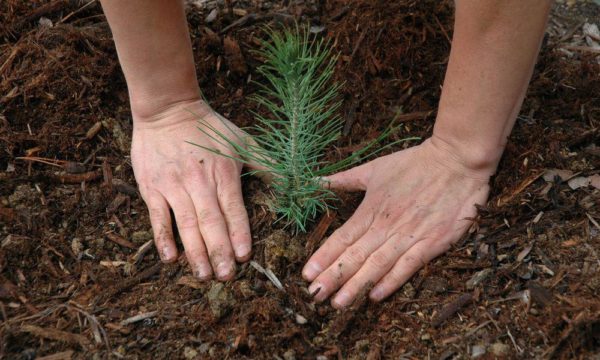

In the middle lane, planting is carried out in early autumn, in the southern regions - in late autumn. The recommendation is not perceived as the ultimate truth. The timing is adjusted up or down, taking into account the weather.
- ½ a bucket of water is poured into a prepared pit;
- the seedling is carefully lowered;
- if the dimensions of the roots with a lump of earth are greater or less than the diameter of the hole, then it is increased or decreased;
- the root collar cannot be buried - it is located strictly above ground level;
- as soon as the summer resident has finished planting pine trees from the forest, he mulches the soil around the trunk;
- mulching is carried out using old pine needles;
- after planting the seedlings, they are watered with water.
Pine seedlings are watered only with a watering can. If you plan to plant several pines on the site, then you should take a measuring device in your hands. Botanists are unanimous, it is better to plant pines on your site at a distance of 3.5-4 m from each other.
Diseases and pests
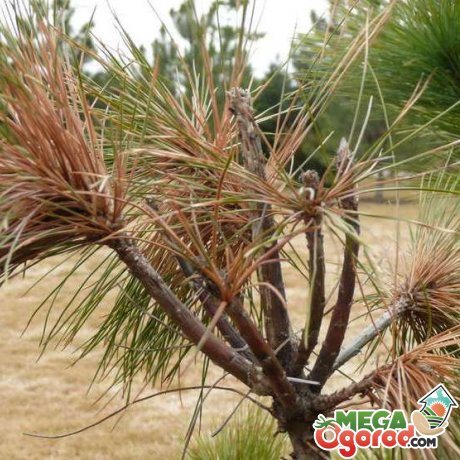

Of the diseases of pine trees in decorative plantings, blistering rust or seryanka is most often found. This can be seen by the yellow bloom at the ends of the needles. Such trees are not treated, they are removed from the site and destroyed.
To prevent the disease, it is necessary for preventive purposes to regularly treat trees with preparations containing copper in the composition.
The most common pests that can attack a tree are aphids and caterpillars. They mainly settle on the edges of young shoots and damage buds and needles. They can be removed with special insecticides by treating all trees and plants that grow nearby.
Care advice
Coniferous trees do not need to be inspected regularly. They grow on their own, provided that the gardener observes the rules of care. The health of young trees should be monitored:
- Planting in late fall increases the risk of sunburn. Seedlings are insulated with foil. If the planting of pines on their site was shifted to the spring, then they are covered with a protective covering from the sun's rays. Watering plays an important role.
- A moderate supply of moisture will help to grow powerful trees.The soil should be slightly damp, not marshy. The second rule is that fallen leaves and debris should not accumulate around the root circle. They are the source of disease. Pests are always found in the mud.
Pruning is a must. As soon as the needles are planted, the summer resident monitors the condition of the branches. They should not be dry or with traces of pathological changes. As soon as something like this makes itself felt, they are cut off. You can't hesitate.
Pine is an evergreen tree that is planted on a personal plot. The seed is taken from the nursery. There you can be sure of its quality. The second possible source is forest. Option for those with sufficient experience. A phased pine transplant is carried out with the ground around the rhizome, otherwise the risk of death of the seedling increases. The second rule - you cannot take seedlings older than 3-5 years - a bad omen in all respects. The older the tree, the more painful it reacts to transplantation. If the gardener decides to transplant the pine within the site, then the manipulation is carried out in early spring.
Why do pine needles turn yellow and how to deal with it?
It often happens that pines, or rather their needles, suddenly begin to turn yellow (especially in autumn or early spring), but this does not always mean that the tree is sick with something.
Important!
Every 3-5 years, almost all ephedra shed their old needles. This is a normal natural process.
The reasons for the yellowing of pine needles can be: incorrect planting of a seedling or its transplant:
the wrong choice of soil mixture and non-compliance with the planting rules, untimely care, namely, insufficient watering or excessive feeding, as well as a spring burn. For example, it is necessary to plant only in sufficiently loose soil, in which there is always sand. Do not deepen the root collar. If the weather is dry, the tree should not forget to water and even sprinkle. For the winter, young seedlings are recommended to be shaded and covered.
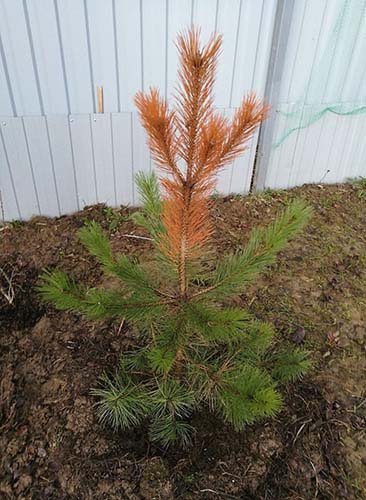

If you do not doubt that you did everything correctly, then it is quite possible that your tree has picked up fungal disease (Schütte) or is it the work of pests
, which can be eliminated using
contact fungicide and insecticide.
Video: why pines turn yellow and what to do
To make your summer cottage play with new colors and shapes, transplant a young pine seedling to your site. However, this must be done carefully and wisely, following the recommendations and advice on the correct transplantation of a coniferous tree.
Video: how to plant a pine tree correctly
Pine is beautiful evergreen tree
, which comes in different varieties. This coniferous plant can decorate any area. It grows very quickly and remains green and fluffy all year round.
Among other things, this tree sprays a large amount of phytoncides that kill disease-causing microbes around the site.
But how to plant a pine tree correctly?
The answer to this question can be found in this article.
How to plant a pine tree in the fall
In order to plant a tree on your site, you need planting material. Of course, you can grow it yourself, but it is easier to purchase it in a nursery or dig it up in the nearest forest. The most favorable time for planting such trees is April or September. This planting time helps them to root well and gain strength.
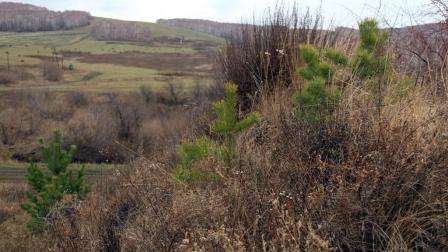

It is necessary to transplant a young pine with a piece of land so as not to damage the fresh shoots of the roots, which help in the nutrition of the plant. If you find yourself in the forest in the summer, and you want to dig out a pine tree you like for transplanting, do not rush to do this, it is better to mark the place before autumn. In the summer, a phase of active growth begins, so the sprout may die.
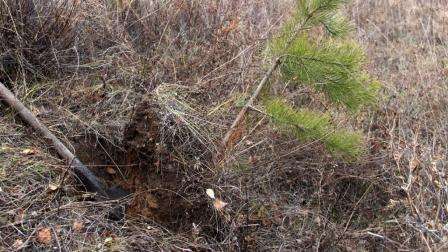

But if, nevertheless, it is unbearable, and you are afraid not to remember the place, then carefully dig it out, taking part of the earth with roots. After transplanting, it is necessary to cover the plant, which will help to suspend its growth somewhat and increase the chances of survival.
Before planting the selected seedling, you should pay attention to the place where the pine will grow later. Do not forget that a tree can reach considerable size, so the area must be large. The pine tree cannot be simply planted in soil.
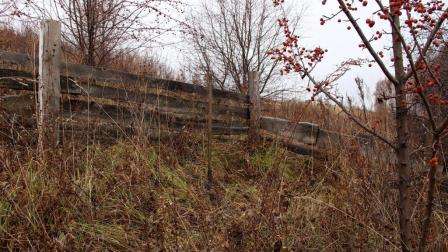

Choosing a place for pine on the site
The land needs to be prepared, to make it looser. To achieve this effect, a drainage layer of sand, elements of stones and an admixture of fertile soil about 20 cm high is laid on the bottom of the pit. This will ensure a good outflow of water and the roots will not rot.
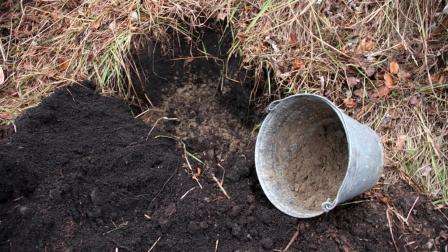

Drainage layer
What kind of land is suitable for planting?
Dense and heavy soil negatively affects pine. Planting is best done in light, sandy soil, on the upper layers of which the compost should be
or manure (do not use Californian worm compost, as it is very dense and does not allow air to pass through). To lighten the soil, drainage is used (20 centimeters of sand are poured into the pit).
Pine needs the following minerals;
- Magnesium
- Potassium
- Calcium
- Phosphorus.
But it is worth considering that a large amount of nitrogen is extremely dangerous for conifers. This trace mineral interferes with the formation of chlorophyll and can lead to the death of some parts of the tree.
Before planting a tree on the site, some use containers. They perfectly save space and are convenient to use, but it is worth considering that pine is a fast-growing tree, it needs a large amount of land. Among other things, containers are convenient if, due to the unfavorable season, it is impossible to plant a pine tree.
How and when to plant and replant in spring
The planting of blue spruce, juniper, fir and other coniferous trees, popular in our country, can be carried out not only in the fall, after the heat subsides, but also in early spring, even before the onset of very hot weather. The technology and rules for planting conifers are as follows:
- If the site is represented by heavy and clayey soils, then it is necessary to provide the plants with drainage from brick scraps and sand.
- The distance between the planted conifers depends on the characteristics of the growth and development of the tree: dwarf varieties should be planted at a distance of 30-35 cm, and tall plants are planted at a distance of 50-70 cm.
- Most types of coniferous crops grow well on soils, which include turf, peat, humus and sand in a ratio of 2: 2: 2: 1, with the addition of 0.25 kg of nitrophoska or 0.15 kg of Kemira-universal.
- A good result is obtained by introducing about 8-10 kg of sawdust into the planting pit when planting fir seedlings.
- When planting seedlings of yew, pine and Cossack juniper, it is advisable to add lime to the planting pit.
Watering
Mugus pine tolerates both drought and high humidity well. Therefore, the plant practically does not require additional watering. Fallen needles form a kind of bedding, of good thickness. This traps moisture at the base. We can say that pine is able to adapt to any climatic conditions.


However, if it is watered during a very dry period, it will become even more attractive. How does mountain pine Mugus tolerate winter? Planting and caring for a plant is available to any gardener. Pine has good winter hardiness. Its branches are very strong and do not break under the weight of snow. Strong winds are also not terrible for this representative of the plant world. In addition, pine protects the soil from erosion.
Expert advice
The most widespread method is the cut to the kidney, which involves pruning according to the following rules:
- indicators of inclination of the cut to the kidney should be no more than 45 degrees;
- the elevation of the lower edge above the base should be about 2-2.5 mm;
- lifting the branch, pruning should be performed on the outer bud, and in the presence of inclined branches, the cut is made on the inner bud;
- if it is necessary to rotate the branches in the tier, then a side cut is performed;
- shortening the shoots assumes the length of the bacon is no more than a couple of centimeters.
Growing from seeds
At home, pine is most often propagated in the same way as in nature - by seeds. They usually reach maturity by mid-January, at this moment, you can start collecting planting material. Fall seeds can also be used, but their germination rate will be much lower.
The cones that have fallen from the ephedra must be brought into the house and put in a container, for example, in a cup, and put on a battery - then after a few days the scales open and the seeds spill out onto the bottom of the container.
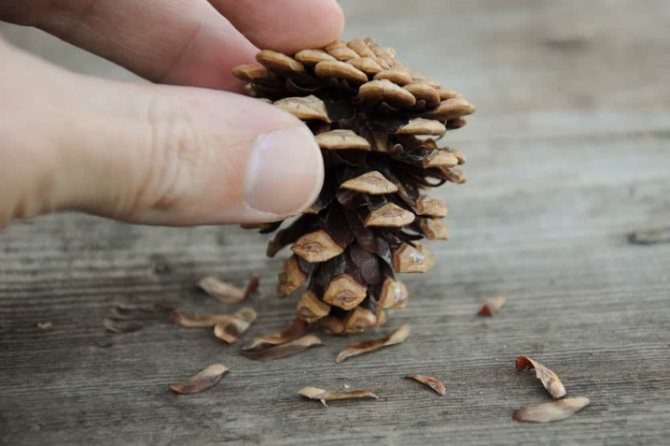

Planting is done in winter or spring.... In the first case, the seeds are placed in boxes, and in the second, directly into the open ground. It is believed that the first method allows you to keep germination under control and therefore is more effective, and in the open field the seeds often become food for rodents.
Stratification is not required for these seeds, but it can speed up germination. It is known that in their natural habitat, seeds begin to germinate after winter swelling in melt water and subsequent warming with the onset of spring. These conditions can be simulated at home. To do this, the planting material is placed in wet sand and placed in the freezer, kept for a couple of months, then taken out, rinsed in warm water and put back in the sand, but in a warm place.
Such measures are necessary if you plan to plant seeds in the fall, otherwise they may not germinate.
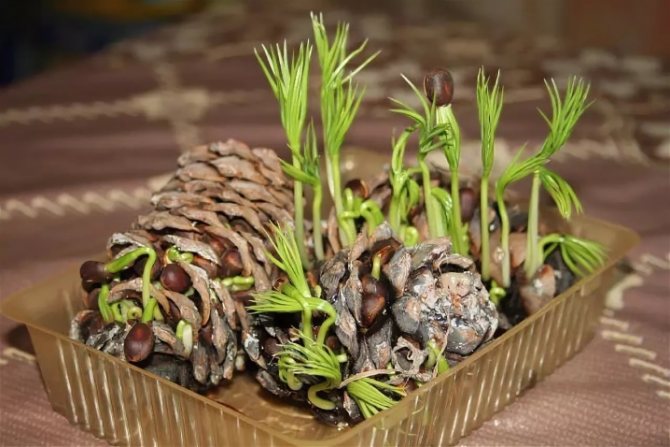

If you intend to plant seeds directly in open ground, you should prepare planting holes. To do this, dig a hole in the ground. a depth of 35-45 cm, drainage is poured onto the bottom with a layer of 20-25 cm, and a soil mixture is laid on top, consisting of peat, turf and sand in equal parts.
Small seeds are buried 1 cm, leaving a distance of 5-6 cm between them.Of course, seedlings can appear even with a denser planting, but then they will raise the top layer of the earth and open unformed young roots, and this will inevitably lead to drying out of the seedlings ...
After planting, the hole should be mulched; for this, crushed coniferous bark, sawdust or a layer of peat are used.
In order for pine seeds to germinate, they must be moistened, since water goes down very quickly from the sandy soil. It is advisable to irrigate the land several times a day. If germination is carried out in a box, you can do it easier - put the containers in trays with water and cover them with plastic wrap. Evaporating, the water will remain on the surface of the film without leaving the space.
The first shoots begin to appear a month after planting.


Mountain pine Mugus - description
The plant has great plasticity, therefore it is popular with designers. It can grow in three types:
- shrub, occupying a volume of 2x2 m;
- a small tree with one trunk;
- elfin, creeping on the ground.
Description of Mugus pine:
- Spherical crown. For decoration, it can take a carpet form.
- Dense needles are light green in spring. By winter, the shade darkens.
- Twisted needles grow in pairs. Their length is about 4 cm. The lifespan is 6-8 years.
- On strong branches, short shoots bent upward with a dense "hedgehog" needles grow. Over time, they become coarse, acquiring a light brown color.
- At the ends of the young, cone-shaped cones of golden color appear after seven years of plant growth.
- Ash brown bark flakes off scaly. With age, it becomes covered with brown growths. This is a sign of all rocks.
- The highly branched root system of the mountain pine Mugus allows it to grow in the most unpretentious mountainous terrain.


Diseases of the mountain pine Mugus
The plant is resistant to diseases and pests. However, under certain growth conditions, it can get sick. The most common diseases and pests of mountain pine:
- Blister rust
... Fungal disease affects the needles in the fall. The needles turn yellow. After the mycelium penetrates into young shoots, branches and the trunk itself. They are covered with orange bumps. They are treated with chemicals containing copper compounds: vitriol, oxychlorides (Abiga-peak), metalaxyl (Arcerid). Application - spray with aqueous solutions. - Scleroderriosis
... This type of fungus spoils the tops of young shoots. The affected needles turn brown and crumble from the touch. The disease spreads from the ends of the branches to the trunk. Effective countermeasures are fugitive (Bordeaux liquid and copper sulfate). - Pine silkworm, scoop
... These are caterpillars devouring pine needles. They are able to eat the entire green mass of the plant. Insecticides kill pests. Lepidocide is diluted with water and sprayed on trees (3 liters per hectare). - Aphid (pine hermes)
... It also feeds on the juices of needles, drying it out. Aphid larvae are covered with a white layer of needles. Over time, the crown turns yellow and crumbles. The affected areas are treated with Karbofos, Decis and other insecticides. The procedure is repeated once a month throughout the season. - Bark beetles
... The pest is identified by sawdust near the roots on the ground. The bug eats the bark of the plant. The tree is sprayed with means from the Bifenthrin group. Treatment must be continued from mid-spring until the onset of cold weather.
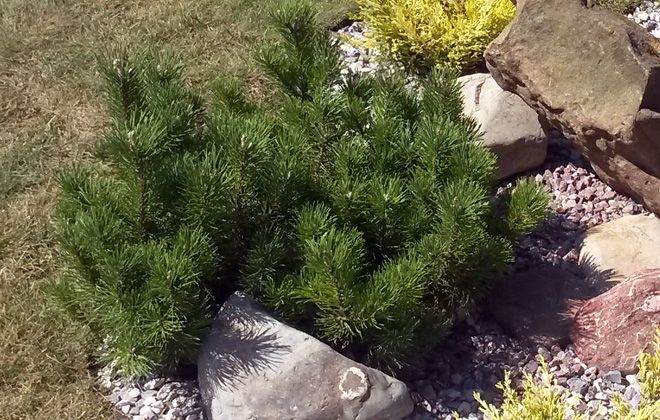

Breeding by cuttings
Pine can be propagated even with a cuttings - a small twig. This process is very slow, but the end result will undoubtedly please all conifers.
A similar breeding method belongs to asexual. This means that during the cultivation of a young ephedra, new gene variations will not be formed and the resulting plant will be completely identical to the parent.
Propagation by cuttings is usually carried out in June-July.... During this period, the branches will be sufficiently formed, but at the same time they will not yet leave the stage of active growth. Due to the long daylight hours, the cuttings have time to completely take root. In regions with warm climates, pine can be propagated earlier this way. But in winter, these works will not lead to success, since the daylight hours are short and during this time the cuttings simply do not have time to get enough of natural light. Rooting will be very slow, although artificial lighting can be a good solution to this problem.
It is not difficult to grow a pine tree from a twig. To do this, you should find a wild pine and cut off a young branch from it. The younger it is, the sooner the first roots will appear.
The branch is removed with pruning shears, the length of the process should not exceed 9-10 cm.
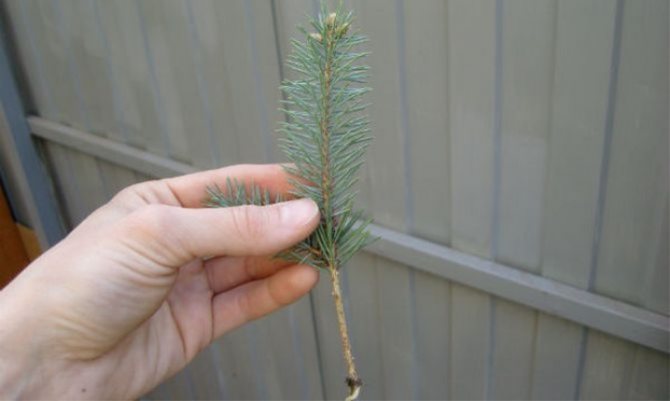

When propagating by branches, the rate of root emergence is largely determined by the composition and structure of the soil. The more fertile the substrate, the more active is the formation of the root system. It is best to use a mixture of sand and peat, taken in equal amounts. As a drainage, coarse peat or rotted bark of conifers can be added to the prepared substrate. It is advisable to add a little perlite - it will provide aeration and facilitate the flow of oxygen to the roots.
Peat contains a large number of various microorganisms, while some of them do not have the best effect on the condition of the tree, therefore the prepared soil must be disinfected first. To do this, it can be calcined or treated with a pale solution of potassium permanganate.


Immediately before rooting, the cuttings should be treated with "Kornevin" or any other stimulant of root formation. The more lignified the scion is, the more saturated solution you will need.
It is best to take a wooden frame or greenhouse as a planting container. In both cases, the future seedling must be covered with a film.
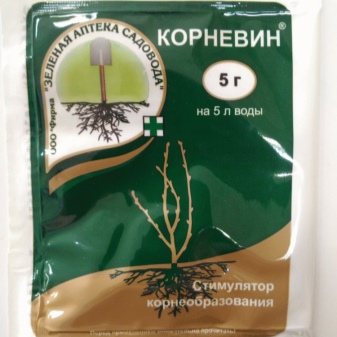

Keep in mind that when cultivating pine with shoots, in no case should you plant a branch immediately in open ground - this will have the most unfavorable effect on the root formation and survival of the plant as a whole. The sequence of actions for rooting cuttings is as follows:
- the prepared container must be filled with soil mixture and moistened;
- using any solid object in the ground, make a depression and place a branch in it;
- the top layer of the soil should be crushed and compacted;
- to prevent the appearance of rot, the landing site must be additionally sprayed with a solution of a fungicidal preparation.
Germinating branches prefer partial shade, so they need to be protected from bright sunlight. Water the seedling as needed and in moderation. The shoots need a constant flow of water, but if it turns out to be more than necessary, the root system will simply rot. The film must be removed from time to time so that the seedlings are ventilated. Usually, full-fledged roots begin to form after 4 weeks, the general rooting process takes 2-4 months.


After a year, branches with roots become suitable for transplanting into open ground. The more powerful and strong the root system is at this moment, the more likely it is that the plant will take root in the ground and go into active growth.
It is better to choose shaded places for planting, but it is better to avoid full shade. The soil should be sandy loam with low acidity. Planting is best done in spring on a cloudy but warm day.
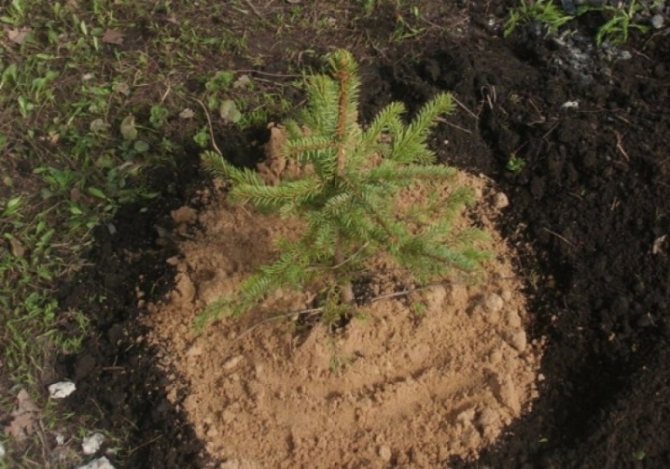

To begin with, you should prepare a planting hole about 1 m deep, the width of the hole should be 2-3 times the diameter of the earthen coma. The bottom is laid out with expanded clay, pebbles or any other drainage with a layer of 10-15 cm. After that, the pit is filled with a mixture of river sand and turf in a ratio of 3 to 1, a seedling is placed there, sprinkled with soil mixture, compacted and watered.
At the end of the work, the near-trunk area should be mulched.
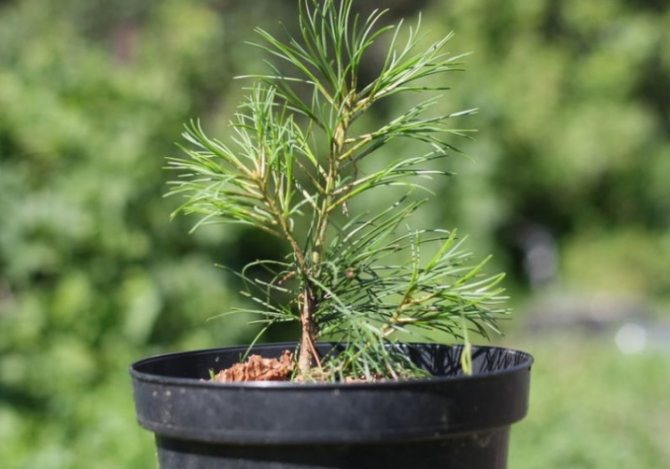

This method is most suitable for inexperienced gardeners - it does not require special knowledge and skills in working with plants.
Growing a pine tree at home is easy. But still, regardless of which method you use, be prepared for the fact that you will be able to get a new tree only in a few years. If you do not have a fair amount of patience, it is better to purchase a ready-made seedling in any nursery.
For information on the features of pine reproduction, see the next video.
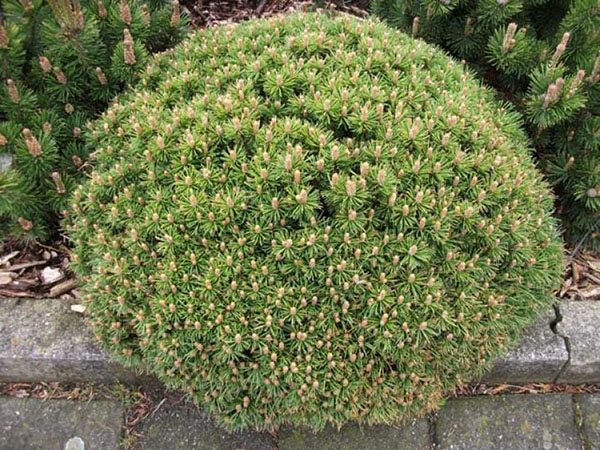

At all times, evergreens were used to decorate the backyard of a country house. Refined mountain pine takes a special place among its relatives. All year round, she does not take off her green outfit, which exudes a pleasant aroma.
The birthplace of the plant is considered to be central and southern Europe. In its natural environment, it is found on the slopes of the mountains. Mature trees grow up to 6-10 m in height. Mountain pine is actively used to form backyard landscapes and urban areas.
Transplanting large pine trees. Transplant of coniferous large-sized
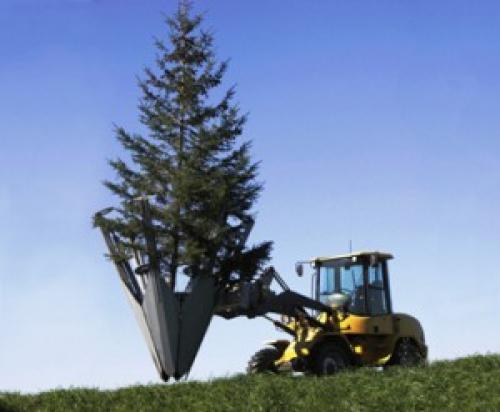

Planting even the smallest seedling requires maximum effort and knowledge, and even when transplanting a large coniferous tree (spruce, pine, cypress), professional help is needed, since this work is very hard, requiring significant physical effort, great knowledge in gardening, digging and preparing for moving and landing. Of course, replanting old trees is not recommended, since their survival rate is minimal, and the stress during digging and moving will be significant. Choose coniferous trees no more than 15-20 years old for transplanting.
About one year before transplanting a large coniferous tree, prepare the tree. Earlier in the spring, before the onset of the growing season, dig a hole around the tree with a shovel, half a meter deep and slightly wider than the crown of the tree.Carefully chop off all surface roots with an ax and clean. The cuts of the roots should break off sharply and be smooth, then they should be lubricated with garden pitch.
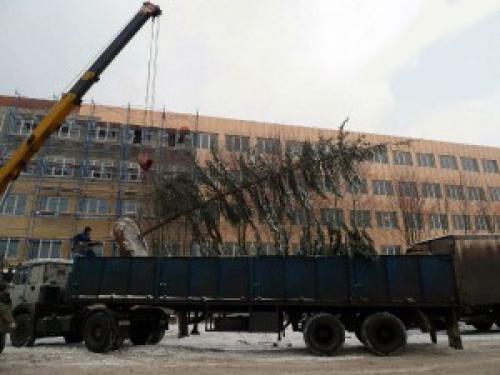

Fill the dug hole around the tree with soil (turf, peat, rotted manure taken 1: 1: 1), you do not need to tamp, but only water it well. Further, throughout the summer, the tree needs to be thoroughly shed periodically. By the way, you shouldn't worry about felled roots: the trimmed roots will overgrow with new fibrous ones during the season. It is these roots that will make it possible for a large coniferous tree to survive a transplant more or less easily.
In the fall, you can start transplanting the large ephedra. Think in advance how you will deliver the tree to its destination, because this is not a seedling that you can freely carry in your hands, but a large coniferous tree. If you don't have your own freight transport, then I advise you to resort to the services of people involved in freight transportation (freight transportation of 5 tons across Russia). I also do not recommend ordering a car for a smaller volume: if
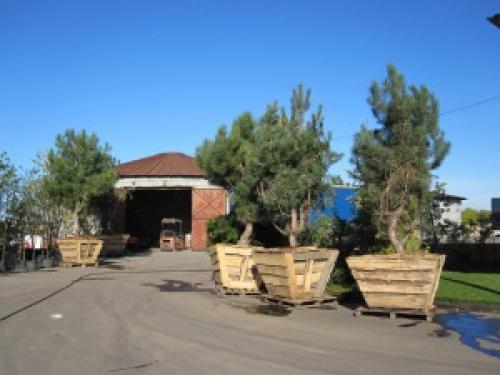

the crown can still be estimated at some weight approximately, then the roots can be miscalculated. Therefore, let the machine be designed for more weight.
It is necessary to dig the ephedra from the outside of the hole dug in the spring, so as not to damage all the overgrown fibrous roots. It is advisable to involve more people in this work, otherwise the digging process alone may take a long time, and the bare roots will suffer. After digging and transporting the tree to the desired location, prepare a planting hole. Its size should significantly exceed the size of the root system of the transplanted tree.
The soil for filling the voids should be made up of special soil. It is not recommended to bury the tree with soil extracted from the hole when digging. In such a land there are few useful substances, it is poorly ventilated, which will negatively affect rooting. So, the soil should be as follows: 1 part of sod land, 1 part of leaf, 1 part of sand, 1 part of peat, 0.5 part of straw. All voids must be spilled, if uncovered areas remain, the tree may subsequently tilt or fall altogether. Transplanting a tree is not small, so you should still take into account the possibility of an uneven installation. Then the tree is spilled with a lot of water.
When transplanting large trees, be sure to take into account the orientation to the cardinal points, otherwise sunburn of the branches and trunk is possible. If transplanted incorrectly, a tree can grow poorly or stop growing altogether. After planting, the ground around the tree should be mulched so that moisture does not quickly evaporate from the surface.
When to plant, in spring or autumn: conifers and fruit trees?
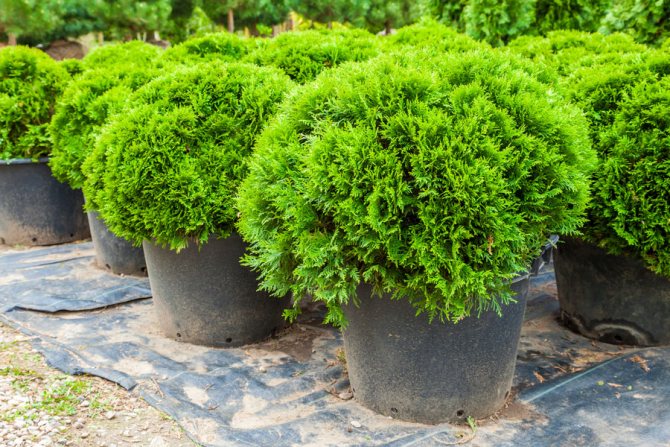

Recently, a woman told me at a lecture that her decorative pine tree had died, could not stand the winter, and that, in her opinion, pine trees did not take root in our country at all. I told her that she probably bought a pine seedling in the fall, and the woman confirmed this.
How do perennials "ruin" gardeners? Firstly, they are more expensive, and secondly, they have to spend wintering, which they will not tolerate. Let us examine these two completely real facts separately.
Sapling cost is largely related to the issue of psychology: oddly enough, the larger the plant, the more valuable it is in the eyes of most buyers. Even if it is a rare variety, but if it is represented by a sprout the size of a matchbox, then for most summer residents this is a "catch" for which money is a pity.
Sellers "guess" about this, so they try to give the planting material large sizes at any cost. And here they are faced with an ordinary law of nature: perennials develop much more slowly in the first year than annuals. They have different growth rates in the first year.
Indeed, if an annual is capable of swinging from a seed into a bush up to the waist and higher in one summer, then perennials will even give modest shoots from a cuttings, and even from a seed, even more so.You cannot get a tall seedling of juniper, clematis, etc. from the cuttings in the same summer. So they keep perennials in the nursery for several years, as a result of which their cost increases.
Therefore, tall planting material for many ornamental and fruit crops costs, as a rule, from 500 rubles. Accordingly, losses from the destruction of at least one object are unpleasant.
Why purchased perennials often do not tolerate wintering? Yes, all because of its large size. In order for them to have an impressive presentation, manufacturers literally pump them up with easily digestible fertilizers. All their time in the nursery, the seedlings receive continuous feeding, they are not allowed to mature, prepare for winter. Their watery stems cannot stand the frost in any way.
How, then, do they endure the winters at the producers themselves? Warm! Somewhere in the south, or in a greenhouse, or in a refrigerator with a constant temperature of 0 ° C. (You know that since those seedlings that you buy in the spring have so magnificently blossomed leaves and even flowers, it means that they spent the winter in a greenhouse.)
Coniferous seedlings: why it is necessary to plant in spring
People often turn to me with questions why cypress, juniper, and fir do not hibernate. Friends, conifers are not strawberry whiskers or peonies, they are much more vulnerable plants. It is enough to dry them once together with the root - and hello, they will not recover; it is enough to pour them with saline solution once - and the same result will be achieved.
The first wintering after purchase is also a great test for these plants. Although they are by their nature and frost-hardy, but this is only with a healthy preparation for winter: their stem must mature, woody, become tough, assimilate and process all the nutrients. If the plant was driven to growth all the time, pumped with nitrogen, then its stems remain loose, green until winter and will not tolerate frost.
How to be? First rule, which I usually follow when acquiring vulnerable conifers, is to give preference spring purchase, not autumn... By purchasing plants in the spring, you have the opportunity to successfully prepare your recruits for the winter.
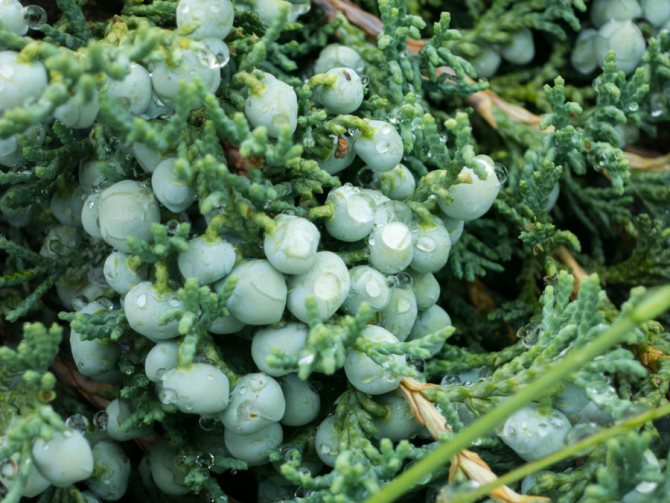

What is needed for this? Plant in the sun. In the greenhouse, they had insufficient lighting, and with a lack of sun, as we know, nitrates and other substances do not break down completely, but accumulate in the tissues, upsetting the balance in them.
In addition, it is necessary abundant watering... You should water new plants more often throughout the summer so that the fluid cycle will remove the "chemistry" from them, the pesticides that were loaded into them in the nursery.
And no fertilizers, no top dressing! The soil should be well-groomed, moderately fertile, optimal for a given crop in order to provide a noticeable increase without fertilizing, since in the very first summer it is important for us to increase the volume of the plant - its stems and foliage, so that the "chemistry" is dispersed, this will reduce its concentration in the tissues ...
With this care, the plants have time to recover and prepare well for the winter, if you bought them in May and even June. Especially in the case of a sunny summer. Starting next year, you can already feed the beginners along with all your other plants. As a rule, plants that have survived the first winter stay in your garden for a long time.
Thus, when buying vulnerable, poorly hibernating perennials, it is better to go against the rules that welcome autumn planting. Buying seedlings of conifers, bulbs, grapes, roses and other ornamental crops before winter is too risky, it is better to postpone their purchase until the spring.
What conifers can be planted in summer
In summer, conifers can be planted, but only those that have a closed root system, that is, they are sold in pots. But there is one unpleasant moment that can nullify all good intentions.
The fact is that, as a rule, we cannot be completely sure whether the seller transplanted a coniferous plant into a pot from an open ground before selling it to us as a container crop.
If such a phenomenon has taken place, there is practically no chance that the ephedra transplanted in the summer will take root in a new place. Even if the plant looks healthy when you buy it, and you create very attractive conditions for its growth.
That is why experienced gardeners do not advise planting container conifers purchased from unverified sellers in the summer. These plants are more likely to be planted in spring or fall.
Apple and pear seedlings: when to plant trees
However, apple or pear seedlings from a local nursery can be safely bought in September-October, as these are hardy crops, and in addition, when planting, they can be surrounded by a mound of earth, hiding part of the trunk above the grafting site from frost.
And yet, when buying seedlings of fruit trees, you need to be even more careful than when buying decorative perennials. In general, growing apple, pear and some other fruit trees is much more difficult than, say, ornamental or vegetable crops. Why?
When you are dealing with cucumbers, strawberries, junipers, you are dealing with whole plants, and an apple or pear is a grafted plant. Imagine that an organ has been transplanted to a person - how much more difficult it is for this organ to work than for the native one: now it cannot be loaded, like the previous organ, it needs a sparing diet, etc.
Our fruit trees are the same. As long as the care is exemplary, moderate loads, well-oiled nutrition, the apple tree regularly bears fruit, because the connection between the top and bottom, the rootstock and the scion, is ensured. But as soon as the loads are injected, the rejection of the vaccine begins. We do not understand well that when an apple tree gets sick with black cancer, or branches dry out on it, or a tinder fungus settles - all this forms of vaccination rejection. At the same time, the root is struggling to emit growth, because it is still tenacious, you cannot take it so easily.
So it turns out that you need to handle the apple tree very carefully, moderate the load, avoid large doses of fertilizers, select soft fertilizers, prevent soil acidification, facilitate pruning, lighten the crown, and select favorable neighbors.
An apple tree or a pear is a completely man-made plant, it needs care, it cannot grow by itself. And in our gardens, they grow abandoned, and their owners are still surprised why they do not bear fruit. Yes, they are busy with survival, where else can they bear fruit! And if you start working hard with them, they will no longer bear fruit again. So it turns out that only very savvy people can get regular harvests of fruits.
And now appreciate how we treat the purchased apple tree saplings: they keep them at home for several days before they go to the hacienda! Is that how they treat transplanted organs? If you have already bought seedlings, they must be transported and planted immediately, postponing all matters. The best conditions for planting seedlings fruit trees are fast transfer "from ground to ground": they are dug up and planted on the same day in a permanent place.
External features of culture


The evergreen beauty is a shrub with graceful short shoots. They almost always point upward, regardless of the variety. Some are creeping in character and extend several meters from the main trunk. The length of the needles is about 4 cm. The needles of a low-growing pine tree in the country are collected in miniature bunches. They are tough and prickly to the touch. The needles are painted dark green. Some varieties are golden or grayish green in color.
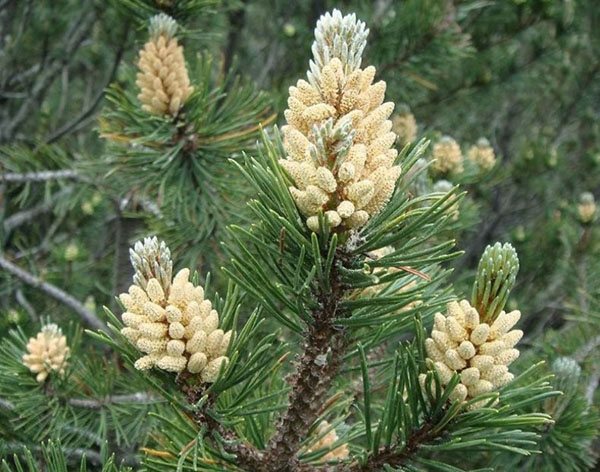

During the flowering period, the shrub puts on a "mantle" of light brown paniculate bouquets. Observe this beauty in May. Cones ripen only the next year at the end of autumn.At first, they are colored gray-green, and then they acquire a brown tint. The minimum size of cone-shaped fruits is approximately 5 cm.
The mountain pine trunk has a unique feature. Its bark changes its color. The young tree is distinguished by a brownish-gray trunk of a smooth character. Over time, dark-colored scales form on its upper part. Therefore, the bottom of the trunk looks much lighter than the top.
In 1 year, the plant grows about 6 cm. It perfectly tolerates heat and winter cold.
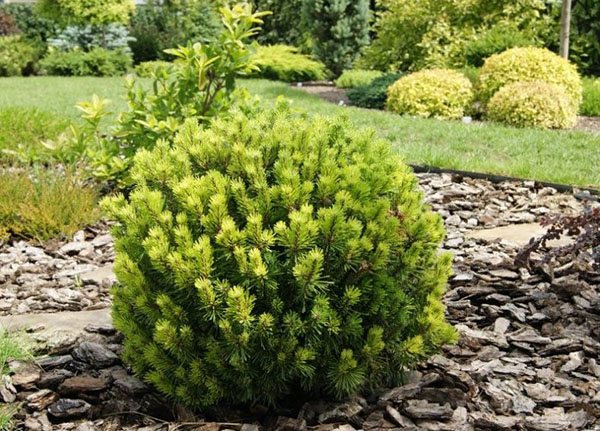

Depending on how long the pine tree has been growing, varieties are selected that are ideal for the territory.
There are a huge number of decorative options:
Each of them has a unique crown shape, color of the trunk and needles, unique miniature fruits. Since the roots of the pine tree are up to 2.5 m deep, they can withstand strong gusts of wind wonderfully. Various parts of the plant are used in folk medicine to treat bronchitis and nervous disorders. And, of course, culture is a chic decoration of a summer cottage.

